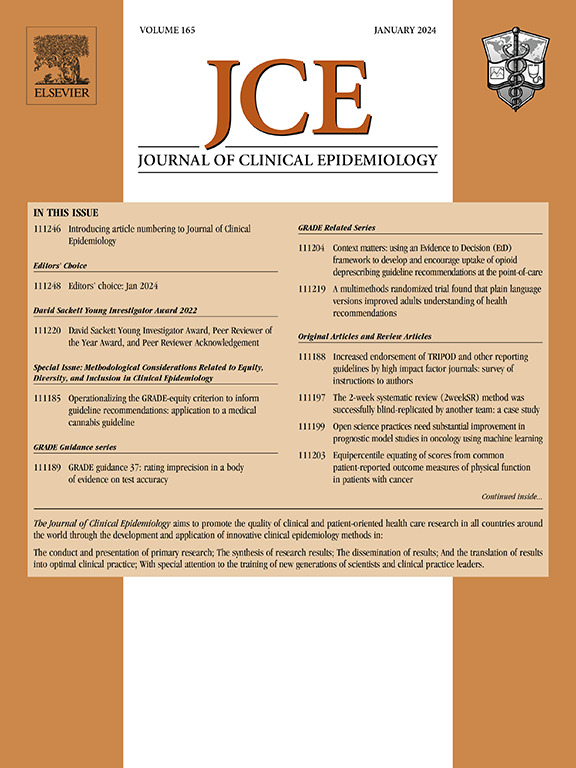对用于评估卫生指南制定过程的 panelview 工具进行跨文化调整和西班牙语验证。
IF 7.3
2区 医学
Q1 HEALTH CARE SCIENCES & SERVICES
引用次数: 0
摘要
目的:PANELVIEW 问卷从指南制定小组的角度,确定制定健康指南过程和方法的优缺点。为扩大其使用范围,PANELVIEW 最好能有不同语言版本。我们的目标是将 PANELVIEW 跨文化改编成西班牙语,并评估其可接受性、有效性和可靠性:为了将 PANELVIEW 翻译成西班牙语并进行文化适应性调整,我们遵循了 ISPOR 的翻译和文化适应性良好实践原则指南。这一过程包括:1)正向和反向翻译;2)专家小组的意见;3)认知汇报访谈。我们与指南制定方面的专家一起评估了内容有效性,他们对工具项目的相关性进行了评分,以确定项目和量表的内容有效性指数(I-CVI;S-CVI)。我们与西班牙语国家的卫生指南小组一起测试了可靠性,并测量了内部一致性(克朗巴赫α)。我们通过每个项目缺失回答的数量来检验可接受性:结果:回译本与原版的内容对比显示,大多数项目(24/34)在概念上是等同的,但在语法上存在差异。通过认知访谈,我们发现 6 个项目存在措辞问题,10 个项目存在清晰度问题,2 个项目存在适用性问题。I-CVI 在 0.77 到 1.00 之间,有两个项目需要修订。S-CVI 为 0.92,显示出极好的内容效度。PANELVIEW 西班牙语版显示出非常好的可靠性(Cronbach's alpha 系数为 0.96)。小组成员对所有项目都做出了回应,显示出良好的可接受性:PANELVIEW 西班牙语版本在概念上等同于原始版本,在可接受性、有效性和可靠性方面都提供了令人满意的证据。本文章由计算机程序翻译,如有差异,请以英文原文为准。
Cross-cultural adaptation and validation to Spanish of the PANELVIEW instrument to evaluate the health guidelines development process
Objectives
The PANELVIEW questionnaire identifies the strengths and weaknesses of the process and methods used for developing health guidelines from the guideline development group's perspective. To expand its use, PANELVIEW ideally should be available in different languages. We aimed to cross-culturally adapt PANELVIEW into Spanish and assess its acceptability, validity, and reliability.
Study Design and Setting
To translate and culturally adapt PANELVIEW to Spanish, we followed International Society for Pharmacoeconomics and Outcomes Research's Translation and Cultural Adaptation Good Practice Principles guidelines. The process consisted of 1) forward and back translation, 2) input from an expert panel, and 3) cognitive debriefing interviews. We assessed the content validity with experts in guideline development who rated instrument items for relevance to determine the item content validity index and scale content validity index (I-CVI and S-CVI). We tested the reliability with health guidelines panels from Spanish-speaking countries and measured internal consistency (Cronbach's alpha). We examined acceptability through the number of missing responses for each item.
Results
The content comparison between the back-translation and the original version showed that most items (24/34) were conceptually equivalent but with grammatical differences. Through the cognitive interviews, we identified six items with wording issues, ten with clarity issues, and two with applicability issues. I-CVI ranged from 0.77 to 1.00, with two items needing revision. S-CVI was 0.92, showing excellent content validity. The PANELVIEW Spanish version demonstrated very good reliability (Cronbach's alpha coefficient of 0.96). Panel members responded to all items, showing good acceptability.
Conclusion
The PANELVIEW Spanish version was conceptually equivalent to the original version and provided satisfactory evidence of acceptability, validity and reliability.
求助全文
通过发布文献求助,成功后即可免费获取论文全文。
去求助
来源期刊

Journal of Clinical Epidemiology
医学-公共卫生、环境卫生与职业卫生
CiteScore
12.00
自引率
6.90%
发文量
320
审稿时长
44 days
期刊介绍:
The Journal of Clinical Epidemiology strives to enhance the quality of clinical and patient-oriented healthcare research by advancing and applying innovative methods in conducting, presenting, synthesizing, disseminating, and translating research results into optimal clinical practice. Special emphasis is placed on training new generations of scientists and clinical practice leaders.
 求助内容:
求助内容: 应助结果提醒方式:
应助结果提醒方式:


